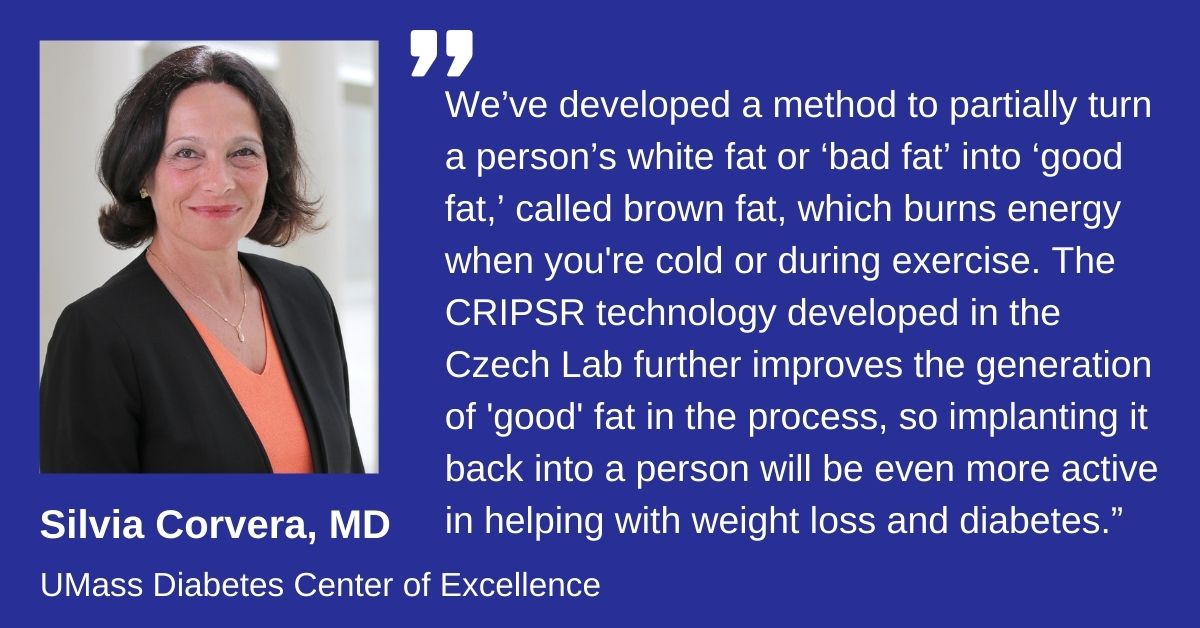Re-engineering “Bad Fat” into “Good Fat” as a Therapeutic Approach to Type 2 Diabetes in the Czech & Corvera Labs
Date Posted: Thursday, October 29, 2020
By now you’ve likely heard of CRISPR technology. In 2021, Emmanuelle Charpentier and Jennifer Doudna were awarded the Nobel Prize in Chemistry for their development of CRISPR/Cas9 genetic editing. The gene editing tool, referred to as "genetic scissors," is used by scientists to alter DNA and modify gene function. Researchers at UMass Chan Medical School have taken it to the next level by developing methods to modify human fat cells in vitro, then transplanting them as a potential therapy for type 2 diabetes and obesity.
The Czech and Corvera laboratories in the Diabetes Center of Excellence and Program in Molecular Medicine, in collaboration with other labs on campus, have combined recent successes to develop a therapy which they hope to soon bring to clinical trials.
The Corvera Lab is turning “bad fat” into “good fat.” The results have shown improved metabolism and glucose tolerance in a humanized animal model being fed a high fat diet.
“We’ve developed a method to partially turn a person’s white fat or ‘bad fat’ into ‘good fat,’ called brown fat, which burns energy when you're cold or during exercise,” said Silvia Corvera, MD, chair in diabetes research and professor in the Program in Molecular Medicine. “The CRIPSR technology developed in the Czech Lab further improves the generation of 'good' fat in the process, so that implanting it back into a person will be even more active in helping with weight loss and diabetes.”

The Czech Lab recently developed a novel way to deliver CAS9 proteins to fat cells, during which they degrade and disappear within hours after editing the DNA of fat cells. This eliminates the negative immune and toxic effects, making it safe for therapeutic applications.
In 2006, the Czech lab discovered a gene called RIP140, that when knocked out, turns white “bad fat” into a brown-like “good fat.” The Corvera and Czech Labs have now begun knocking out RIP140 DNA in human fat cells, then transplanting them into immuno-compromised humanized models.
Using CAS9 gene editing to modify the cells and transplanting them back into the recipient, their studies continue to show a dramatic decrease of fat in the liver, eliminating the precursors to fatty liver disease. They’ve also observed an improvement in glucose tolerance and overall improved metabolism.
Drs. Czech and Corvera have applied for an extension to their grant from The Department of Defense to advance this therapeutic model into pre-clinical studies, with a goal of human clinical trials in the future.
Related Articles
Type 2 Diabetes Research in the Czech Lab Investigating Beige Fat to Potentially Increase Metabolism
The Corvera Lab is Examining How Different Body Fat Plays a Role in Type 2 Diabetes
Corvera Lab Continues to Create "Good Fat" as a Potential Therapy for Type 2 Diabetes
